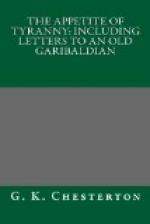Suppose we heard of a person (gifted with some longevity) who had helped Alva to persecute Dutch Protestants, then helped Cromwell to persecute Irish Catholics, and then helped Claverhouse to persecute Scotch Puritans, we should find it rather easier to call him a persecutor than to call him a Protestant or a Catholic. Curiously enough this is actually the position in which the Prussian stands in Europe. No argument can alter the fact that in three converging and conclusive cases he has been on the side of three distinct rulers of different religions, who had nothing whatever in common except that they were ruling oppressively. In these three Governments, taken separately, one can see something excusable or at least human. When the Kaiser encouraged the Russian rulers to crush the Revolution, the Russian rulers undoubtedly believed they were wrestling with an inferno of atheism and anarchy. A Socialist of the ordinary English kind cried out upon me when I spoke of Stolypin, and said he was chiefly known by the halter called “Stolypin’s Necktie.” As a fact, there were many other things interesting about Stolypin besides his necktie: his policy of peasant proprietorship, his extraordinary personal courage, and certainly none more interesting than that movement in his death agony, when he made the sign of the cross towards the Czar, as the crown and captain of his Christianity. But the Kaiser does not regard the Czar as the captain of Christianity. Far from it. What he supported in Stolypin was the necktie and nothing but the necktie: the gallows and not the cross. The Russian ruler did believe that the Orthodox Church was orthodox. The Austrian Archduke did really desire to make the Catholic Church catholic. He did really believe that he was being Pro-Catholic in being Pro-Austrian. But the Kaiser cannot be Pro-Catholic, and therefore




